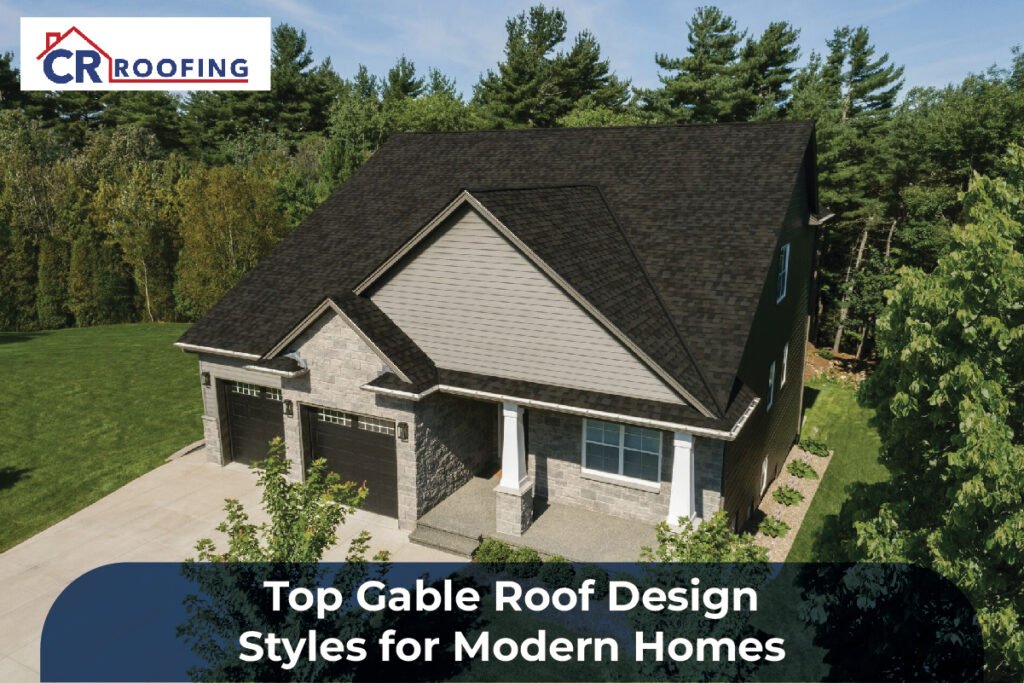When it comes to residential roofing, few designs are as classic and versatile as the gable roof. Characterized by its triangular shape, a gable roof combines timeless beauty with practical functionality. Today, homeowners can choose from a wide range of gable roof design styles that blend traditional aesthetics with modern architectural trends.
At C&R Roofing, we specialize in installing and maintaining high-quality gable roofs that not only protect your home but also enhance curb appeal. Whether you’re drawn to a traditional gable roof style or prefer a contemporary twist, understanding the types of gable roof designs can help you make the best choice for your modern home.
Why Gable Roofs Are So Popular
Before diving into specific styles, it’s important to understand why gable roofs remain one of the most popular choices in roofing:
- Classic Appeal: Their simple triangular form complements both traditional and modern architecture.
- Excellent Drainage: The slope allows rain, snow, and debris to slide off easily.
- Versatility: Works well with different materials like asphalt shingles, metal, or tile.
- Cost-Effectiveness: Simpler gable roof structures are affordable to install and maintain.
- Design Flexibility: Can be adapted into many unique roof variations.
Types of Gable Roof Designs
There are several types of gable roof designs that suit different architectural needs. Let’s explore the most popular options and how they can enhance a modern home.
1. Front Gable Roof Style
The front gable roof style places the triangular face of the roof at the front of the house, often above the entrance. This design is common in Colonial and Cape Cod architecture but has found a place in modern builds as well.
Benefits:
- Creates a strong architectural focal point.
- Adds symmetry and balance to the façade.
- Works well with modern entryways and porches.
Best For: Homes that want an inviting and bold curb appeal.
2. Side Gable Roof Structure
A side gable roof structure features the triangle at the sides of the home, with the roof ridge running parallel to the front. This is one of the simplest and most traditional gable roof styles.
Benefits:
- Clean, classic look suitable for nearly any home design.
- Efficient drainage and snow-shedding capabilities.
- Cost-effective construction.
Best For: Homeowners who want a timeless design with minimal complexity.
3. Cross Gable Roof Design
The cross gable roof design combines two gable roofs at a right angle. It often results in multiple rooflines, creating a more complex and dynamic appearance.
Benefits:
- Adds depth and dimension to modern architecture.
- Creates opportunities for unique interior layouts.
- Ideal for larger homes with multiple wings or extensions.
Best For: Homes with complex floor plans that need architectural variety.
4. Dutch Gable Roof
A Dutch gable combines a traditional gable with a hip roof. The lower part of the roof slopes on all sides, while the gable sits on top.
Benefits:
- Adds extra attic or living space.
- Enhances ventilation and natural light.
- Provides a stylish blend of modern gable roof architecture and hip design.
Best For: Homeowners who want both functionality and a unique roofline.
5. Box Gable Roof
A box gable roof is similar to the front gable style but features a boxed-in section at the triangular face, creating a more defined and solid appearance.
Benefits:
- Offers strong geometric lines for a contemporary look.
- Enhances the modern aesthetic of minimalist homes.
- Provides additional stability in windy climates.
Best For: Modern homes emphasizing bold, angular architecture.
6. Gable Roof with Shed Extension
This variation includes a traditional gable roof with an additional shed-style slope. It’s practical for adding extra living space without major structural changes.
Benefits:
- Creates additional space for sunrooms or extended kitchens.
- Blends modern and traditional elements.
- Provides flexible design opportunities.
Best For: Homeowners who want more usable interior space while keeping the gable look.
Modern Gable Roof Architecture
Today’s architects and builders are taking the traditional gable roof style and giving it a modern twist. Modern gable roof architecture often features:
- Sleek lines and minimal overhangs.
- Large windows set into the gable face for natural light.
- Contrasting materials, such as metal roofing with wood siding.
- Open interior ceilings that highlight the roof’s slope.
This style works especially well for contemporary homes, cabins, and minimalist designs that emphasize clean geometry.
Choosing the Right Gable Roof for Your Home
When deciding on a roof style, consider the following factors:
- Home Size and Layout – Larger homes may benefit from cross gables, while smaller homes look great with simple side gables.
- Climate – Steeper slopes are ideal for snowy regions, while less dramatic slopes work well in mild climates.
- Budget – More complex gable designs, like Dutch or cross gables, cost more than simple side gables.
- Curb Appeal Goals – Do you want classic simplicity or bold, modern architecture?
At C&R Roofing, we help homeowners weigh these factors to choose the perfect gable design that balances style, function, and cost.
Read More: Signs You Need Gable Roofing Contractors for Repairs
FAQs About Gable Roof Design Styles
1. What is the most common gable roof design style?
The side gable is the most common due to its simple structure and cost-effectiveness.
2. What’s the difference between front gable and side gable roofs?
Front gables face the street with the triangular end, while side gables place the triangle on the sides.
3. Is a cross gable roof more expensive?
Yes, because it involves more complex construction and materials. However, it adds significant architectural value.
4. Are gable roofs good for modern homes?
Absolutely. Modern gable roof architecture combines clean lines and unique materials to create contemporary curb appeal.
5. Which gable roof style adds the most space?
Dutch gables and gables with shed extensions are great for maximizing interior and attic space.
